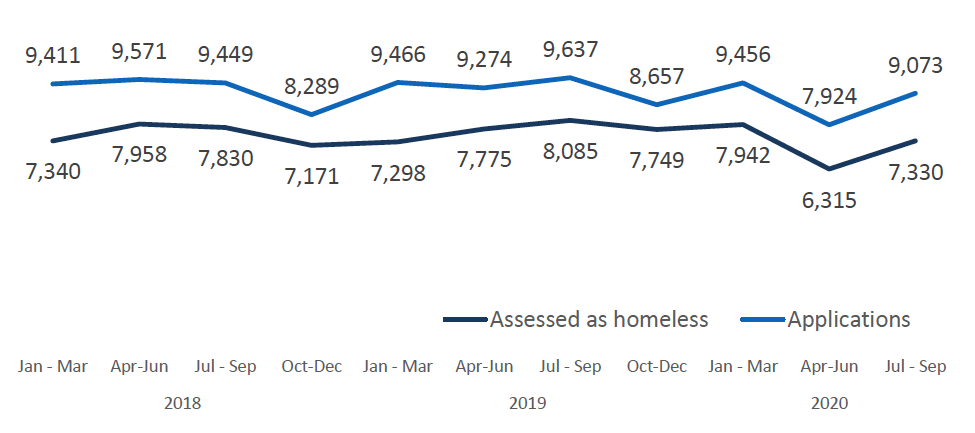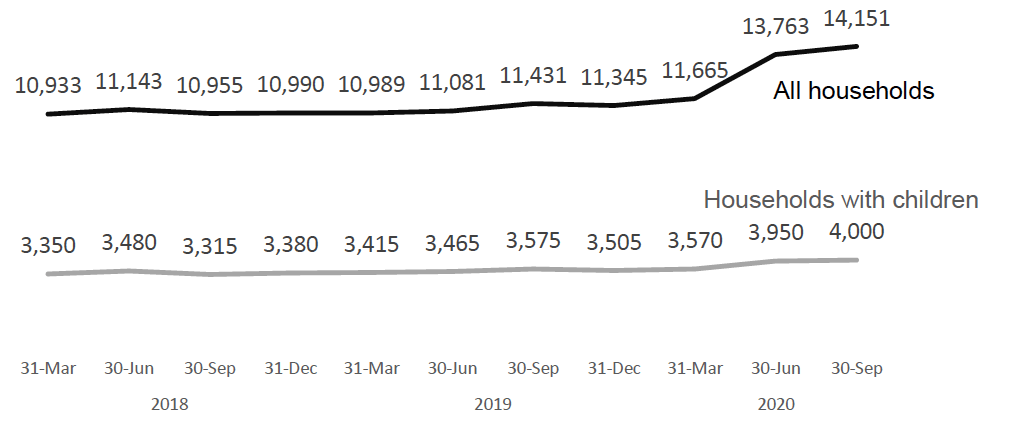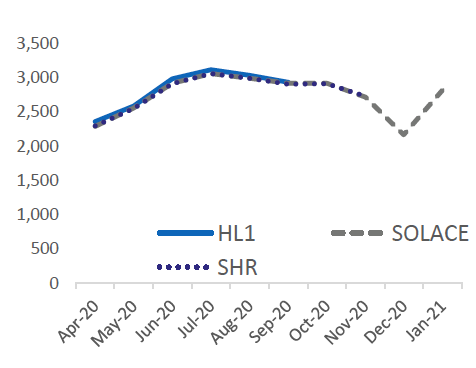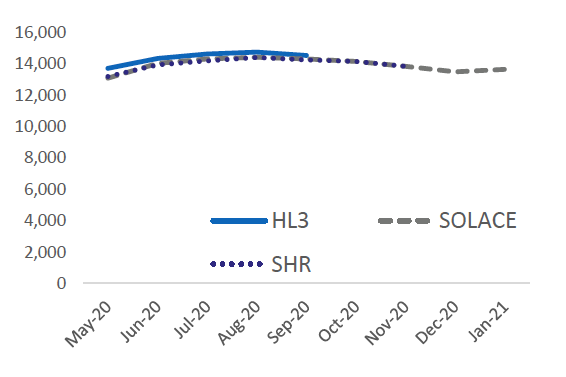Homelessness in Scotland: update to 30 September 2020
This statistics bulletin provides information on homelessness in Scotland in the 6 month period from 1 April 2020 to 30 September 2020, alongside historical data.
This document is part of a collection
The Extent of Homelessness in Scotland
Key Points
Between April and September 2020:
- 16,997 homeless applications were received - 10% less than 2019
- 13,645 households were assessed as homeless - 14% less than 2019
As at 30 September 2020 there were:
- 27,332 open homelessness cases – 20% more than 2019
- 14,151 households in temporary accommodation – 24% more than 2019
Applications, assessments and households in temporary accommodation
Differing trends have been experienced in homelessness over the 6 month period 1 April to 30 September 2020.
| Apr -Sep | Change | |||
|---|---|---|---|---|
| 2019 | 2020 | Number | Percentage | |
| Applications | 18,911 | 16,997 | -1,914 | -10% |
| Assessed as homeless | 15,860 | 13,645 | -2,215 | -14% |
| Open cases as at 30 September | 22,783 | 27,332 | 4,549 | 20% |
| Households in temporary accommodation as at 30 September | 11,431 | 14,151 | 2,720 | 24% |
Table A shows that while there has been a decrease in applications and households assessed as homeless over the 6 month period, there has been an increase in the number of households in temporary accommodation. New analysis has been included this year to show the number of open homelessness cases; this also shows an increase from the same period in 2019. (Tables 1, 6, 7 & 14)
The trends can largely be explained by changes in service use as a result of the covid-19 pandemic. Some local authorities have reported a reduction in presentations as households were reluctant to approach homelessness services while covid-19 guidelines advised households to remain at home, meaning households whose housing needs were less urgent opted to remain in their current accommodation. In addition, a reduction in the number of evictions due to emergency coronavirus legislation temporarily extending eviction notice periods also reduced the number of households presenting as homeless from social rented housing, and more noticeably from private rented housing.[2] Furthermore, home repossessions were also temporary banned in this period.[3]
Covid-19 restrictions limited the ability of local authorities to move households in to permanent accommodation, and therefore close cases, explaining the increase in the number of open homelesssness cases. This included difficulties in carrying out necessary repairs, challenges conducting viewings due to households shielding or self-isolating, and a lower level of lets due to staff, especially registered social landlords, being furloughed.
There are a couple of reasons for the increase in the number of households in temporary accommodation. First, the rise in the number of open cases increased overall demand for temporary accommodation. In addition, some households who had previously chosen not to take up temporary accommodation provided by the local authority, now required it as the alternative arrangements they had made were no longer viable due to the pandemic.
The drop in applications and assessments are mainly driven by figures for April to June, with these increasing again between July and September (Chart 1). Monthly figures (with the caution that these are subject to natural variation) show that applications for April and May 2020 in particular were considerably lower compared to 2019, with figures for June 2020 comparable to the previous year (Table 29).

Chart 2 shows that the increase for households with children and/or pregnant women in temporary accommodation isn't as steep as for households overall (24% increase for all vs 12% for households with children/ pregnant women). There were a total of 7,900 children in temporary accommodation at 30th September – a decrease of 9% (from 7,245) the previous year. (Tables 14-16)

Changes in homelessness assessments
There were a total of 16,568 applications assessed in the 6 month period, 13,645 (82%) of which were found to be homeless or threatened with homelessness. Of these, 13,645, 13,382 (98%) were assessed as unintentionally homeless, with the remaining 263 assessed as intentionally homeless. There is a decrease in the proportion assessed as intentionally homeless compared to the same period last year (2% vs 3%) – this is likely due to changes in legislation which, from November 2019, allows local authorities the power to assess for intentionality rather than it being a legal duty to do so. (Table 7)
Local authority differences
The fall in households assessed as homeless was not experienced uniformly across Scotland. The largest decrease in the period April to September 2020 was seen in Edinburgh, where 1,184 households were assessed as homeless (a decrease of 573, 33% compared to the same period in 2019). Other notable decreases were seen in North Lanarkshire (700 households, a decline of 241, 26%) and Glasgow (2,318 households, a decline of 216, -9%). (Table 8)
The biggest increase in temporary accommodation was seen in Glasgow, with 3,179 households in temporary accommodation at September 30th, an increse of 862 (37%) compared to September 30th 2019 (Table 14). This is related to the large drop in failures to accommodate in Glasgow – see temporary accommodation section.
Comparisons with administrative data sources
During the course of the pandemic, the collection of monthly management information was set up by the Scottish Government (SG), on behalf of SOLACE, and the Scottish Housing Regulator (SHR) to monitor the impact of covid-19 on homelessness.
The number of applications and households in temporary accommodation reported by official statistics (HL1 & HL3) and monthly management information (SOLACE & SHR) sources are extremely similar for April/May-Sep 2020.


From the management information it can be seen that the number of applications have remained fairly stable from October onwards, with the exception of the dip in December, which is usual. Temporary accommodation figures peaked in August and were continuing to decline until January 2021, where there was a slight increase again.
Contact
There is a problem
Thanks for your feedback